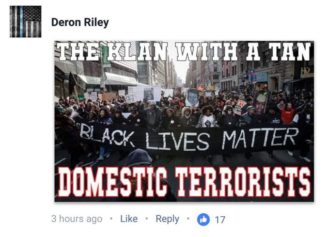
Hundreds of protesters stand outside of the St. Louis city jail on Monday, Sept. 18, 2017. The protesters chanted “free our people” outside the jail on Monday night to show solidarity with those who remain behind bars. Police said that more than 120 people were arrested during Sunday’s protests. (David Carson/St. Louis Post-Dispatch via AP)
ST. LOUIS (AP) — Protesters chanting “free our people” gathered outside the jail in downtown St. Louis for more than two hours to show solidarity with those arrested during demonstrations that turned ugly over the weekend, but there was no new vandalism overnight.
Demonstrators outside the jail late Monday criticized authorities for keeping some of those arrested in jail for nearly 24 hours after they were taken into custody. Police said more than 120 people were arrested during Sunday’s protests over the acquittal of a white former police officer in the killing of a black suspect.
Some of those jailed were released Monday evening before organizers announced an end to the demonstration and told people to go home. Organizers said protests will resume Tuesday, but they gave no details.
Monday was the fourth day of protests.
Three days of peaceful protests and three nights of vandalism followed Friday’s announcement that a judge found ex-officer Jason Stockley not guilty in the 2011 death of Anthony Lamar Smith.
Smith’s mother, Anne Smith, was among those gathered outside the downtown jail Monday.
Hundreds of riot police mobilized downtown late Sunday, arresting more than 80 people at one intersection who police said didn’t follow orders to disperse. Earlier, police had responded to reports of property damage and vandalism.
But Sean Porter, 25, of St. Louis, was among those arrested at the intersection. He said they could not follow orders to disperse because police had them blocked in.
“They threw us on the ground, sprayed us, hit us, everything. It’s tragic,” said Porter, who was released from jail Monday evening. He was charged with failure to disperse.
The St. Louis Post-Dispatch said reporter Mike Faulk, who was on the street covering the protests, had an experience similar to the one Porter described.
Police blocked all four sides of the intersection using a corralling technique called kettling. Faulk heard the police command to move back, but he had nowhere to go, the newspaper reported. Multiple officers knocked Faulk down, he told the Post-Dispatch, and pinned his limbs to the ground. A foot pushed his head into the pavement and he was squirted with pepper spray after he was subdued, he said.
Several others caught in the box made by rows of riot police said the officers overstepped their bounds and used excessive force on non-protesters, including residents trying to get home.
Tony Rothert, legal director of the American Civil Liberties Union of Missouri, said his office has been busy fielding complaints and is “exploring whether litigation will be necessary to bring police in line with the Constitution.”
Police said anyone who wants to make a complaint can contact the Internal Affairs Division.
Protesters had marched peacefully through St. Louis’ posh Central West End and the trendy Delmar Loop area of nearby University City during daylight hours on Friday and Saturday. Protesters also marched through two shopping malls in a wealthy area of St. Louis County. On Sunday, more than 1,000 people had gathered at police headquarters and then marched without trouble through downtown St. Louis. Silent protesters marched arm-in-arm to city hall during the Monday morning rush hour crush.
But on Sunday night, 100 or so people who remained on the street grew agitated, knocking over planters, breaking shop and hotel windows, and scattering plastic chairs at an outdoor venue as they headed downtown.
They were met with riot police who made the arrests and seized at least five weapons, according to Interim Police Chief Lawrence O’Toole. Later, officers in riot gear gathered alongside a city boulevard chanting “whose street, our street” — a common refrain used by the protesters — after clearing the street of demonstrators and onlookers.
Stockley shot Smith after high-speed chase as officers tried to arrest Smith and his partner in a suspected drug deal. Stockley, 36, testified he felt endangered because he saw Smith holding a silver revolver when Smith backed his car toward the officers and sped away.
Prosecutors said Stockley planted a gun in Smith’s car after the shooting. The officer’s DNA was on the weapon but Smith’s wasn’t. Dashcam video from Stockley’s cruiser recorded him saying he was “going to kill this (expletive).” Less than a minute later, he shot Smith five times.
Stockley’s lawyer dismissed the comment as “human emotions” during a dangerous pursuit. St. Louis Circuit Judge Timothy Wilson, who said prosecutors didn’t prove beyond a reasonable doubt that Stockley murdered Smith, said the statement could be ambiguous.
Stockley left the police department and moved to Houston three years ago.


